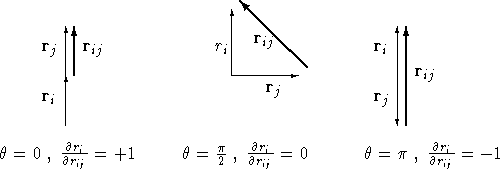
In the case of optimising , the choice of parameters to optimise was obvious as the function is expressed as a Fourier expansion. In the case of the Jastrow function, this choice is not so clear. The current Jastrow factor has the form
where ![]() is given by
is given by
In an attempt to improve on the above function it was decided to add
an extra term into the exponential in Eq.(![]() ) to take
account not only of the electron-electron separation,
) to take
account not only of the electron-electron separation, ![]() , but
also of the individual positions of the electrons
, but
also of the individual positions of the electrons ![]() and
and
![]() . It was suspected that the region where correlation
effects are likely to deviate most strongly from the symmetric
correlation described by the standard Jastrow function will be close
to the ionic cores. Therefore, the any new function,
. It was suspected that the region where correlation
effects are likely to deviate most strongly from the symmetric
correlation described by the standard Jastrow function will be close
to the ionic cores. Therefore, the any new function, ![]() should be
short ranged and centred on each of the ions. For simplicity, the
should be
short ranged and centred on each of the ions. For simplicity, the
![]() function was chosen to be a function of the distances of the 2
electrons from the ion,
function was chosen to be a function of the distances of the 2
electrons from the ion, ![]() and
and ![]() and the
electron-electron separation
and the
electron-electron separation ![]() , with no angular dependence. It
must also obey the following conditions:-
, with no angular dependence. It
must also obey the following conditions:-
![]()
Now condition ![]() specifies
specifies ![]() , therefore
, therefore
Finally, expanding ![]() gives
gives
![]()
We chose to keep electron j fixed (i.e.
![]() )
and move electron i through
it, to test the behaviour as
)
and move electron i through
it, to test the behaviour as ![]() .
As the angle between
.
As the angle between ![]() and
and ![]() varies
between 0 and
varies
between 0 and ![]() the value of
the value of ![]() will vary smoothly between -1 and
+1, (see figure
will vary smoothly between -1 and
+1, (see figure ![]() ).
).

Figure: Dependence of ![]() on
the angle between
on
the angle between ![]() and
and ![]()
Therefore, the only solution to Eq.(![]() ) for all geometries of
electrons is
) for all geometries of
electrons is ![]() .
.
The final form chosen for the new short range function
![]() was therefore
was therefore
The prefactor in Eq.(![]() )
)
![]() performs the following
functions; the
performs the following
functions; the ![]() term removes any terms
independent of
term removes any terms
independent of ![]() or terms linear in
or terms linear in ![]() as specified
above. The
as specified
above. The ![]() term is required to satisfy condition
term is required to satisfy condition
![]() , namely that the function be well behaved as one of
the electrons moves through the ion. The need for this term in the
prefactor was established by performing small simulations using
different forms of
, namely that the function be well behaved as one of
the electrons moves through the ion. The need for this term in the
prefactor was established by performing small simulations using
different forms of ![]() as one electron moves through an ion.
The
as one electron moves through an ion.
The ![]() term enforces the short
range nature of
term enforces the short
range nature of ![]() by forcing it to decay to zero with zero gradient when
one of the electrons is a distance L from the ion.
The remaining part of
by forcing it to decay to zero with zero gradient when
one of the electrons is a distance L from the ion.
The remaining part of ![]() is a general Chebyshev expansion in all three
variables;
is a general Chebyshev expansion in all three
variables; ![]() , and
, and ![]() .
.
It should be noted that there are in fact two separate ![]() functions
required, one dealing with the case where the spins of electrons i
and j are parallel and one where they are anti-parallel. This has
no effect on the choice of functional form, but it does mean that there are
twice as many parameters to be optimised and this reduces the maximum
possible number of terms in the Chebyshev expansion.
functions
required, one dealing with the case where the spins of electrons i
and j are parallel and one where they are anti-parallel. This has
no effect on the choice of functional form, but it does mean that there are
twice as many parameters to be optimised and this reduces the maximum
possible number of terms in the Chebyshev expansion.
It is also worth noting that the final form for ![]() is very similar
to that proposed by Mitas [41], see Eq.(
is very similar
to that proposed by Mitas [41], see Eq.(![]() ). The
difference between the functions is that Mitas only includes even
powers of
). The
difference between the functions is that Mitas only includes even
powers of ![]() whereas the
whereas the ![]() function used here contains
odd and even powers and should therefore be more general.
function used here contains
odd and even powers and should therefore be more general.